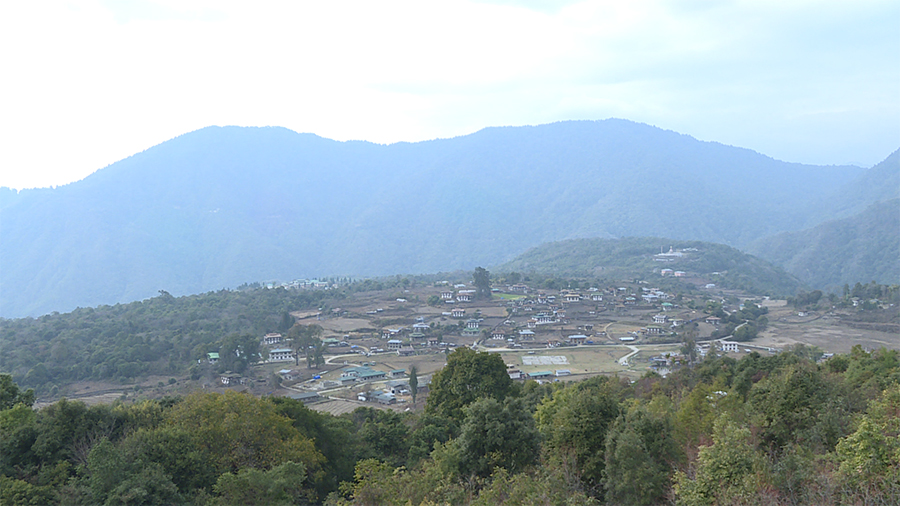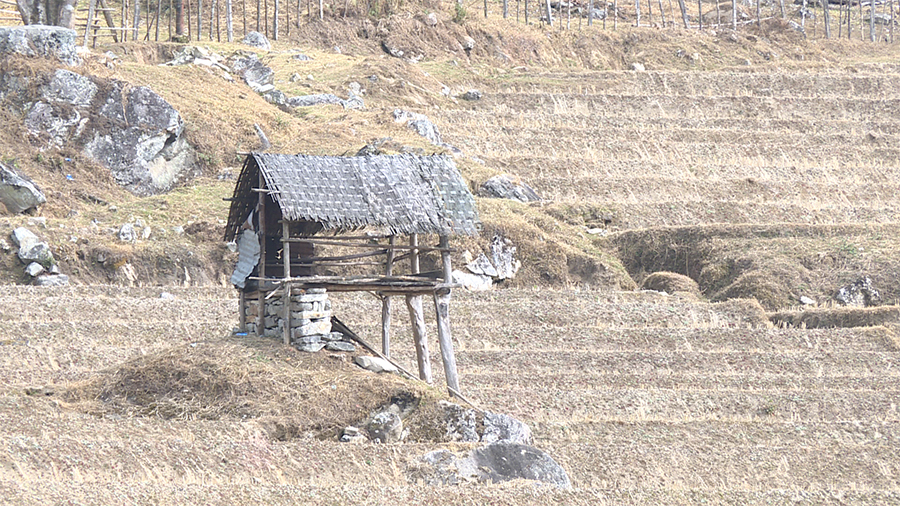
With almost 95 per cent of its area under forest cover, Zhemgang is rich in biodiversity. Its lush forests are home to several plants and animals, including over 22 endangered animal species. But it comes at a cost as the farmers struggle to co-exist with the wildlife. They have to guard their crops all the time against wild animal attacks. The issue is particularly rampant in Nangkor Gewog. Although the district administration has been intervening by providing measures including electric fencing, it could not bring about the desired outcome. The ongoing construction of chain-link fencing in Kikhar village is expected to be a game changer.
 If you are in Nangkor Gewog in Zhemgang, it is common to come across several small huts in the agricultural fields. For instance, it is winter in Buli meaning there is no cultivation around this time of the year.
If you are in Nangkor Gewog in Zhemgang, it is common to come across several small huts in the agricultural fields. For instance, it is winter in Buli meaning there is no cultivation around this time of the year.
And farmers do not have to worry about wild animals frequenting the village, posing risks to both lives and properties. In summer, farmers would spend their nights in these huts to protect their crops from wild animals.
Residents of Buli say the climate in their region is suitable to grow almost all kinds of crops. The farmers here mostly grow potatoes, rice, and maize. But they say it is a challenge to continue farming due to wild animal damaging their crops.
61-year-old Dorjila says wild boars damage their paddy and potato fields just when the crops are ready for harvest.
“It is difficult to guard the fields against wild boars and deer. We go to guard the crops during the night after a tiring day and the wild boars damage our crops as soon as we fall asleep. The animals usually come when the paddy is ready for harvest. We lose almost half the harvest to wild boars.”
The issue is the same in other villages of the gewog. In Kikhar, the village tshogpa says farmers have started to leave their fields fallow as they struggle to co-exist with wildlife.
“The wild boars and deer destroy our crops and vegetables. When such kind of destruction occurs, farmers are becoming reluctant in doing agricultural work. That is why there is fallow land. There are about eight to nine acres of fallow land in Kikhar,” said Tshering Norbu, Dhakpai-Tali Tshogpa.
To address the issue, the gewog and the district administration have been providing electric fencing to the farmers. But not everyone benefitted from this intervention.
“They are providing electric fencing, which is helpful. However, it is provided to only those who have huge areas of farmland. They do not give it to households with smaller land holdings. So, we have to guard the fields ourselves,” said Tshewang Lhamo, a resident of Buli.
“The fields enclosed with electric fencing are well-protected from wild animals. So, the wild animals ultimately end up damaging the fields that are left unprotected,” said Dorjila.
In Kikhar, the villagers who were provided with electric fencing say although the intervention helped them to some extent, it was not as effective. But things are expected to get better hereafter, at least in Kikhar.
The district administration and Nangkor Gewog started works to install chain-link fencing with support from the Global Environment Facility.
The Nu 3 M worth project to enclose close to 90 acres of paddy fields is expected to make farming a little less exhausting for the rice growers in Kikhar.
“It would be more beneficial if we can install the fence covering the entire village. The electric fencing helped us but it was not so effective. I think chain link fencing is more effective as it has an angle post, wire mesh fence, soling and welding. For wild boars, the foundation of the fence should be strong. They cannot enter if the foundation or the wall is strong,” said Tshering Norbu, Dhakpai-Tali Tshogpa.
“We have yet to start the installation of chain link fencing. But we feel that it will benefit us. I think wild boars, deer and monkeys cannot enter the fields. After the installation of the new fence, we hope to harvest all the crops,” said Thinley Tobgay, a resident of Kikhar.
“Earlier, even if the government provided us with the fence, it could not benefit us. I think chain link fencing will benefit us. In the past, wild boars, deer, and monkeys destroy our crops. Mostly, it is the wild boars who damage the crops,” said Sonam Choden, another resident of Kikhar.
Nangkor Mangmi said chain-link fencing which is expected to last up to 40 years is more durable compared to electric fencing.
“To address these issues, we initially started providing electric fencing. But that is not a sustainable measure as the poles decompose and get damaged after three years or so. So, it could not address the issue completely,” said Sonam, Nangkor Mangmi.
“Initially, electric fencing was effective but in recent years, it was not sustainable. This is because it requires a lot of maintenance and the farmers faced challenges in carrying out the work. This year, as a pilot project, we are installing the chain link fencing in Kikhar village. There are more than 100 acres of fields measuring about three kilometres and the work to install the fence is ongoing,” said Jambay Ugyen, the district Agriculture Officer.
Among other gewogs, Nangkor sees the most cases of human-wildlife issues. The gewog hosts the biological corridor that connects the Jigme Singye Wangchuck National Park, the Phrumshingla National Park, and the Royal Manas National Park.
Innovative interventions like electric and chain-link fencing are crucial to help humans and wildlife co-exist.
This story is supported by the GEF-UNDP Ecotourism Project of the Department of Tourism
Phub Gyem/Tshering Zam






